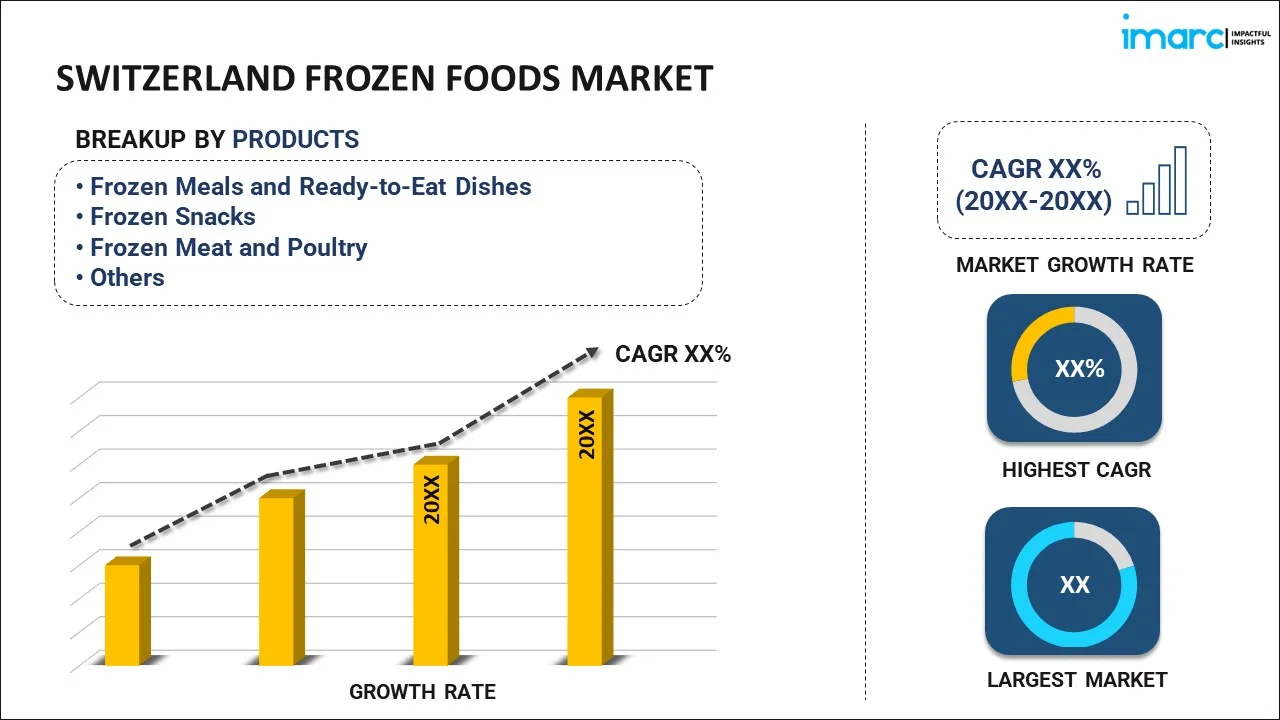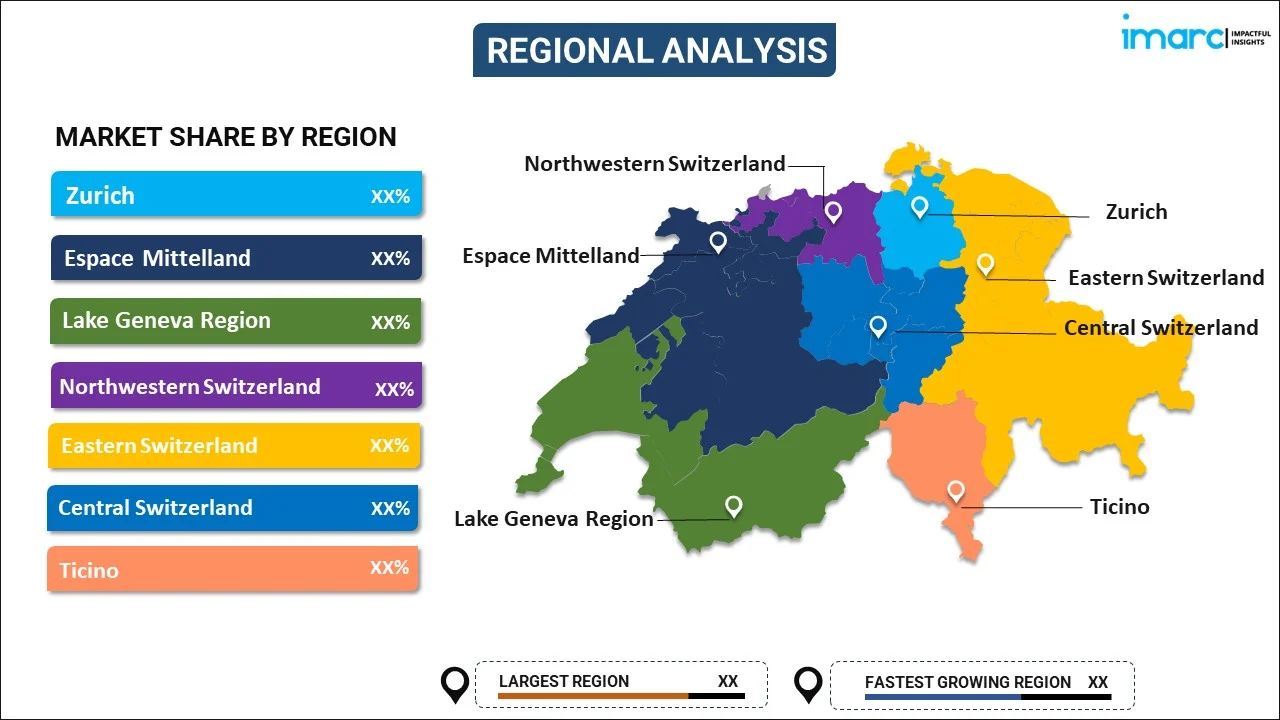
Switzerland Frozen Foods Market Report by Product (Frozen Meals and Ready-to-Eat Dishes, Frozen Snacks, Frozen Meat and Poultry, Frozen Seafood, Frozen Vegetables and Fruits, Frozen Bakery Products, and Others), Distribution Channel (Food Service, Retail), and Region 2025-2033
Switzerland Frozen Foods Market Overview:
The Switzerland frozen foods market size reached USD 520 Million in 2024. Looking forward, IMARC Group expects the market to reach USD 700 Million by 2033, exhibiting a growth rate (CAGR) of 2.9% during 2025-2033. The market is experiencing significant growth, driven by increasing demand for convenience foods, easy availability of various products, including frozen processed meat, poultry, seafood, and bakery items, and rising consumer preference for quick and easy meal solutions to accommodate busy lifestyles.
|
Report Attribute
|
Key Statistics
|
|---|---|
|
Base Year
|
2024 |
|
Forecast Years
|
2025-2033
|
|
Historical Years
|
2019-2024
|
| Market Size in 2024 | USD 520 Million |
| Market Forecast in 2033 | USD 700 Million |
| Market Growth Rate (2025-2033) | 2.9% |
Switzerland Frozen Foods Market Trends:
Growth in Plant-Based Frozen Foods
The Switzerland frozen foods market is witnessing significant growth in the plant-based segment. With an increasing number of consumers shifting toward vegan and vegetarian diets for health, environmental, and ethical reasons, plant-based frozen foods have become a popular choice. This trend is supported by the availability of a diverse range of products such as plant-based burgers, sausages, and ready-to-eat meals. The rising awareness about the environmental impact of meat production also fuels this trend, as consumers seek sustainable and eco-friendly food options. As a result, the plant-based frozen foods segment is expected to continue its robust growth trajectory in Switzerland. According to the Swissveg Association, a recent study from 2022 shows an increase of 14% over 2021 in the number of people following a vegan or vegetarian diet in Switzerland, marking the 5th consecutive year of growth.
Technological Advancements in Freezing Techniques
Advancements in freezing technology are transforming the Switzerland frozen foods market, enhancing product quality and shelf life. Innovations such as Individually Quick Frozen (IQF) technology, which freezes individual pieces of food separately, ensure that frozen products maintain their nutritional value, texture, and flavor. This method prevents the formation of large ice crystals that can damage the cellular structure of the food, resulting in a fresher product once thawed. These technological advancements improve the consumer experience by providing higher-quality frozen foods helping manufacturers reduce food waste and extend the distribution reach. The Swiss Confederation aims to drive food-tech innovation by leveraging its world-class research institutes, solid technological know-how, highly qualified workforce, consumers’ new mindsets, and leading players across the ecosystem. As consumers become more discerning about the quality of frozen products, these innovations are expected to drive further growth in the market.
Increasing Demand for Ethnic and International Frozen Foods
There is a growing demand for ethnic and international frozen foods in Switzerland, driven by the country's multicultural population and the increasing interest in global cuisines. Consumers are seeking more diverse and exotic food options, leading to the expansion of frozen food offerings from various cuisines such as Asian, Mediterranean, and Latin American. This trend is supported by the convenience and accessibility of frozen foods, allowing consumers to enjoy restaurant-quality meals at home without the need for extensive preparation. Additionally, the rise of e-commerce platforms has made it easier for consumers to access a variety of international frozen foods, further boosting the market. In 2021, Switzerland had 6 million ecommerce users. A study by Netcomm Suisse in 2016 shows that the Swiss are only second to the UK in Europe for the amount they spend online each year. Swiss consumers spend €2,149 online annually. As globalization continues to influence culinary preferences, the demand for ethnic and international frozen foods is expected to remain strong, contributing to the overall growth of Switzerland frozen foods market.
Switzerland Frozen Foods Market News:
- In 2023, Frosta AG, a prominent player in the European frozen foods market, introduced a new range of plant-based frozen foods, including vegan fish fingers. This move is part of the company’s broader strategy to capitalize on the increasing demand for plant-based and sustainable food products.
Switzerland Frozen Foods Market Segmentation:
IMARC Group provides an analysis of the key trends in each segment of the market, along with forecasts at the country level for 2025-2033. Our report has categorized the market based on product and distribution channel.
Product Insights:

- Frozen Meals and Ready-to-Eat Dishes
- Frozen Snacks
- Frozen Meat and Poultry
- Frozen Seafood
- Frozen Vegetables and Fruits
- Frozen Bakery Products
- Others
The report has provided a detailed breakup and analysis of the market based on the product. This includes frozen meals and ready-to-eat dishes, frozen snacks, frozen meat and poultry, frozen seafood, frozen vegetables and fruits, frozen bakery products, and others.
Distribution Channel Insights:
- Food Service
- Retail
- Hypermarkets and Supermarkets
- Convenience Stores
- Online
- Others
A detailed breakup and analysis of the market based on the distribution channel have also been provided in the report. This includes food service and retail (hypermarkets and supermarkets, convenience stores, online, and others).
Regional Insights:

- Zurich
- Espace Mittelland
- Lake Geneva Region
- Northwestern Switzerland
- Eastern Switzerland
- Central Switzerland
- Ticino
The report has also provided a comprehensive analysis of all the major regional markets, which include Zurich, Espace Mittelland, Lake Geneva Region, Northwestern Switzerland, Eastern Switzerland, Central Switzerland, and Ticino.
Competitive Landscape:
The market research report has also provided a comprehensive analysis of the competitive landscape. Competitive analysis such as market structure, key player positioning, top winning strategies, competitive dashboard, and company evaluation quadrant has been covered in the report. Also, detailed profiles of all major companies have been provided.
Switzerland Frozen Foods Market Report Coverage:
| Report Features | Details |
|---|---|
| Base Year of the Analysis | 2024 |
| Historical Period | 2019-2024 |
| Forecast Period | 2025-2033 |
| Units | Million USD |
| Scope of the Report | Exploration of Historical Trends and Market Outlook, Industry Catalysts and Challenges, Segment-Wise Historical and Future Market Assessment:
|
| Products Covered | Frozen Meals and Ready-to-Eat Dishes, Frozen Snacks, Frozen Meat and Poultry, Frozen Seafood, Frozen Vegetables and Fruits, Frozen Bakery Products, Others |
| Distribution Channels Covered |
|
| Regions Covered | Zurich, Espace Mittelland, Lake Geneva Region, Northwestern Switzerland, Eastern Switzerland, Central Switzerland, Ticino |
| Customization Scope | 10% Free Customization |
| Post-Sale Analyst Support | 10-12 Weeks |
| Delivery Format | PDF and Excel through Email (We can also provide the editable version of the report in PPT/Word format on special request) |
Key Questions Answered in This Report:
- How has the Switzerland frozen foods market performed so far and how will it perform in the coming years?
- What has been the impact of COVID-19 on the Switzerland frozen foods market?
- What is the breakup of the Switzerland frozen foods market on the basis of product?
- What is the breakup of the Switzerland frozen foods market on the basis of distribution channel?
- What are the various stages in the value chain of the Switzerland frozen foods market?
- What are the key driving factors and challenges in the Switzerland frozen foods?
- What is the structure of the Switzerland frozen foods market and who are the key players?
- What is the degree of competition in the Switzerland frozen foods market?
Key Benefits for Stakeholders:
- IMARC’s industry report offers a comprehensive quantitative analysis of various market segments, historical and current market trends, market forecasts, and dynamics of the Switzerland frozen foods market from 2019-2033.
- The research report provides the latest information on the market drivers, challenges, and opportunities in the Switzerland frozen foods market.
- Porter's five forces analysis assist stakeholders in assessing the impact of new entrants, competitive rivalry, supplier power, buyer power, and the threat of substitution. It helps stakeholders to analyze the level of competition within the Switzerland frozen foods industry and its attractiveness.
- Competitive landscape allows stakeholders to understand their competitive environment and provides an insight into the current positions of key players in the market.
Need more help?
- Speak to our experienced analysts for insights on the current market scenarios.
- Include additional segments and countries to customize the report as per your requirement.
- Gain an unparalleled competitive advantage in your domain by understanding how to utilize the report and positively impacting your operations and revenue.
- For further assistance, please connect with our analysts.
 Request Customization
Request Customization
 Speak to an Analyst
Speak to an Analyst
 Request Brochure
Request Brochure
 Inquire Before Buying
Inquire Before Buying




.webp)




.webp)












